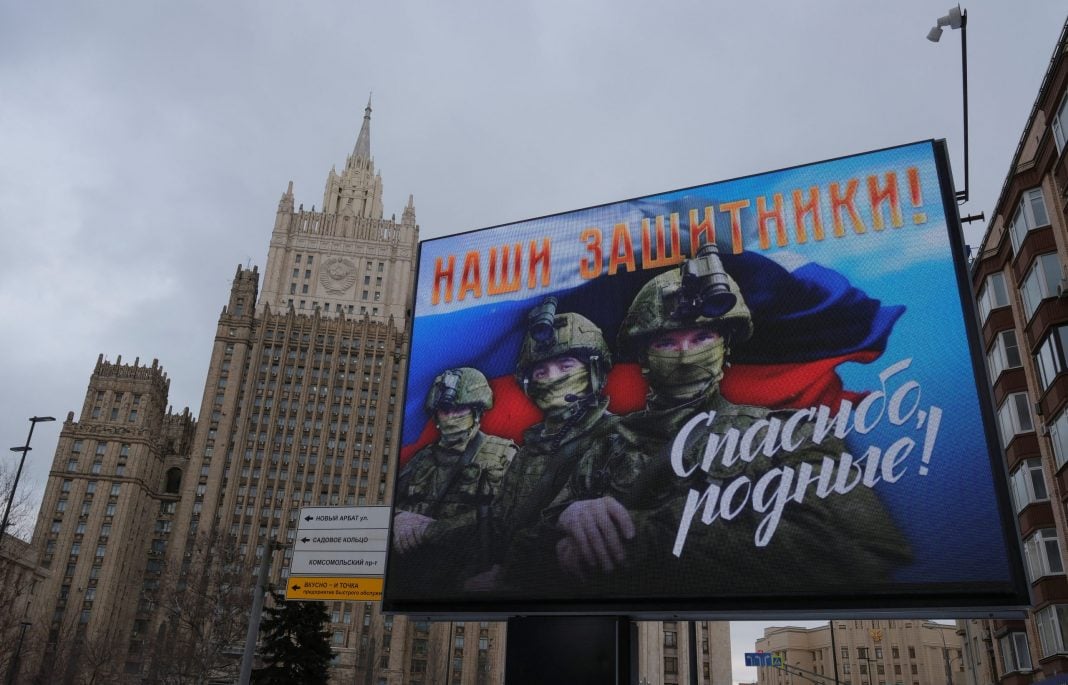By Olga Tokariuk, for CEPA
Long before its full-scale military invasion, Russia waged a disinformation war against Ukraine. It has continued, but will it be successful?
Russia’s ‘Ukrainian Nazis’
A favorite Kremlin trope for years, the claim that Ukraine is “full of Nazis”, was one of the motivations Vladimir Putin gave for his “special military operation” on February 24 last year. The need to “denazify Ukraine” later expanded into other goals in official discourse, but this narrative, present in Moscow’s propaganda at least since Russia’s invasion of Donbas and annexation of Crimea in 2014, resonated with domestic audiences. A big part of the Russian population still supports the war, and the continuation of dehumanizing propaganda about Ukraine has justified and enabled the current genocide.
The handful of remaining independent Russian media outlets have been forced into exile, and it is a continuous struggle for them to overcome the Kremlin’s propaganda machine, which remains the primary source of information for most Russians. While the exiled independent media try to report more or less objectively about war, questions remain about their sometimes sympathetic use of language towards Russian soldiers, illustrated recently by the controversy when Rain TV was stripped of its license by the Latvian authorities.
The Kremlin’s Failure to Reach Ukrainians
In Ukraine, resilience to Russian propaganda and disinformation, developed since 2014, helped the country avoid information chaos in 2022. Pro-Russian TV stations were taken off air as soon as the invasion began, and the United TV Marathon, launched by several of the most important broadcasters in the first days of war, made sure Ukrainians had reliable round-the-clock information from presenters and broadcasters they knew and trusted. It also helped control and counter unverified information and harmful social media posts from Kremlin stooges in the initial phase of the war, which could have led to panic and hindered the ability to resist Russia’s initial push.
As the war has continued, questions have arisen about the wisdom of maintaining the TV Marathon, which is increasingly seen as too close to the government and a source only of good news. However, Ukraine’s media, which faced significant challenges in 2022 (according to the Institute of Mass Information, more than 200 outlets were forced to close because of bankruptcy or Russian occupation), remains diverse and vibrant. There is space for debate, and Ukrainian journalists have not only reported on the war and exposed Russian war crimes but also uncovered examples of Ukrainian corruption.
Russia’s disinformation operations in Ukraine since the invasion has largely failed. Many Ukrainians who once sympathized with Russia have changed their allegiance, after witnessing and experiencing atrocities, and Russian-speakers have switched to Ukrainian in their daily lives, driven by the desire to cut all ties with everything Russian.
Despite the lack of success, Russia will continue to peddle disinformation, with the goal of breaking Ukrainian resistance, sowing internal division, undermining trust in the government and the military, and making people feel apathetic and weak.
Russia’s Disinformation Stumbles in the West
In the West, Russia has failed so far to persuade populations and governments about the necessity of the invasion, or undermine their unity in backing Ukraine. On the contrary, Western public support remained remarkably solid between April and January this year, expressing a widespread willingness to bear increased energy prices because of Russia’s aggression and with, “full majorities in the US, Canada, Great Britain, France, the Netherlands, and Poland support[ing] their country’s providing weapons and/or air defense systems to the Ukrainian military,” according to a 28 country survey by Ipsos.
Western military support to Ukraine has been constantly on the rise since February 2022, and the official rhetoric is that this will continue for “as long as it takes”, as underlined by President Biden during his visit to Kyiv on February 20. Russian attempts to deny its war crimes in Bucha and elsewhere, as well as successful Ukrainian military counter-offensives, have only strengthened this resolve.
Some disinformation narratives have, however, resonated with certain politicians and parts of the Western public. In Italy, for example, public support for sending weapons to Ukraine is decreasing, after months of rhetoric from the governing coalition parties of Matteo Salvini and Silvio Berlusconi, politicians known for close pre-war ties to the Kremlin, as well as the opposition 5 Star Movement and pro-Russian pundits in the media. Russia will seek to exploit such divisions to undermine the unity of the EU and NATO in Ukraine.
Other narratives Russia has used in the West, which it will continue to use in 2023, including highlighting the cost of supporting Ukraine for taxpayers; discrediting the Ukrainian government and military leadership as corrupt, greedy, and ungrateful; stoking resentment over Ukrainian refugees in countries that have the largest share of them (Poland, Germany, etc); and encouraging “war fatigue” and “Ukraine fatigue.”
Russia Finds Support in the non-Western World
In countries of the Global South, including India, Brazil and some African countries, but also NATO member Turkey, Russian disinformation operations have had partial success. In many of these places Russian propaganda channels, such as RT and Sputnik, have not been restricted, unlike in the West, and Russian officials and their supporters are given unchallenged airtime on local media.
Russia exploits the anti-Western and anti-imperialist sentiments in the developing world, portraying itself as a “victim of NATO” and as an alternative to the imperialist West (USA, UK, France, etc.) It campaigns for diplomatic and trade relations for mutual benefit, an important argument for many developing countries facing economic challenges and needing to provide for their growing populations. For Russia, this serves an important need to present itself as still being part of the global community, as a country that is not isolated but still has friends on the world stage.
In the Global South, Russia also manipulates the narrative of the alleged racism of Ukrainians and Westerners. For example, it exploits tensions over more favorable treatment for Ukrainian refugees compared to those coming from Africa, the Middle East, or Latin America.
What Next?
As the Russian war on Ukraine enters its second year, the Kremlin’s disinformation and influence campaigns can be expected to intensify. Most likely, they will be more sophisticated and more nuanced, targeting audiences in specific countries deemed most susceptible.
The primary goal is to undermine the unity of the West, and its solidarity with Ukraine, with a focus on disrupting military support. In other parts of the world, Kremlin disinformation efforts will be aimed to aid its hunt for allies that will help Russia position itself as a strong power, included in the international community despite its war on Ukraine.
As for the topics of these disinformation campaigns, we should expect more efforts to discredit the Ukrainian government, military and civil society. There will be an increasing focus on the perceived high cost of supporting Ukraine, exploitation of war fatigue, and dissent over Ukrainian refugees abroad.
By Olga Tokariuk, for CEPA
Olga Tokariuk is a Ukrainian journalist, a fellow at the Reuters Institute for the Study of Journalism in Oxford, and a non-resident fellow at CEPA.
Europe’s Edge is CEPA’s online journal covering critical topics on the foreign policy docket across Europe and North America. All opinions are those of the author and do not necessarily represent the position or views of the institutions they represent or the Center for European Policy Analysis.





